
Lab Practical 2
Fungal and Lichen Diversity
General characteristics of fungi:
Filamentous
Spore-producing
Heterotrophic
Unicellular or multicellular
Possess a chitin cell wall, store energy in the form of glycogen
Mostly decomposers, but some are parasitic or mutualistic
Release digestive enzymes onto a food source to dissolve it
Hyphae — numerous small filaments that compose multicellular fungi
Mycelium — grouped together mass of hyphae
Septa — cross walls of hyphae that allow structures like ribosomes and mitochondria to pass through
Rhizoids — modified hyphae that anchor fungi into substrate
Basidiomycota
Mushrooms, shelf fungi, and puffballs
Produce basidiospores (similar to the ascus)
Some can be edible

Chytridiomycota
Most ancient group of fungi
Most chytrids are either aquatic decomposers feeding on dead material or parasites living on water molds, insects, or snakes
Cell walls composed of chitin
Have flagellated spores and gametes
Most are unicellular
Can be found outside of water in moist environments

Ascomycoda
Largest and most diverse phylum of fungi
Lives pretty much anywhere
Can be unicellular or multicellular
Gets their name from the ascus, a large saclike cell responsible for producing reproductive ascospores
Fruiting bodies are called ascocarps

Zygomycota:
Bread molds
Reproduce via conjugation
The hyphae lack septa and are called coenocytic
Three types of hyphae: rhizoids anchor hyphae, stolons grow horizontally on the surface
Asexual life cycle: rhizoids make sporangiophores, which make two progametangia that meet and form a zygosporangium, which releases meiospores

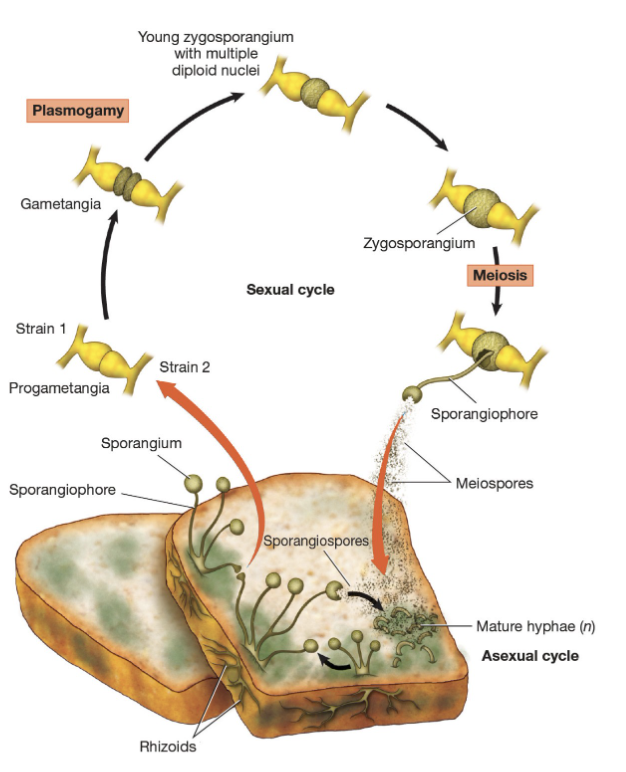
Lichen
Symbionts consisting of a green algae or cyanobacterium
Algal cells or cyanobacteria are thought to provide food for both symbionts through photosynthesis and the ascomycete retains water and minerals, anchors the organism, and protects the algae
Nearly 20,000 species
Body is called a thallus and mainly reproduce asexually
Typically live on trees, rocks, and human structures. But can also live in crazy conditions
Associated with making dyes, litmus paper, bandages, and antibiotics. They help build soil, provide food and habitat, some fix nitrogen and are indicators of air pollution.
Three types:
Crustose: form brightly colored patches or crusts on rock or tree bark
Foliose: appear to have leaf like thalli that overlap, forming a scaly, lobed body. Found on tree bark and human made structures
Fruticose: appear shrub-like or hanging mosslike on trees. Thalli are highly branched or cylindrical.
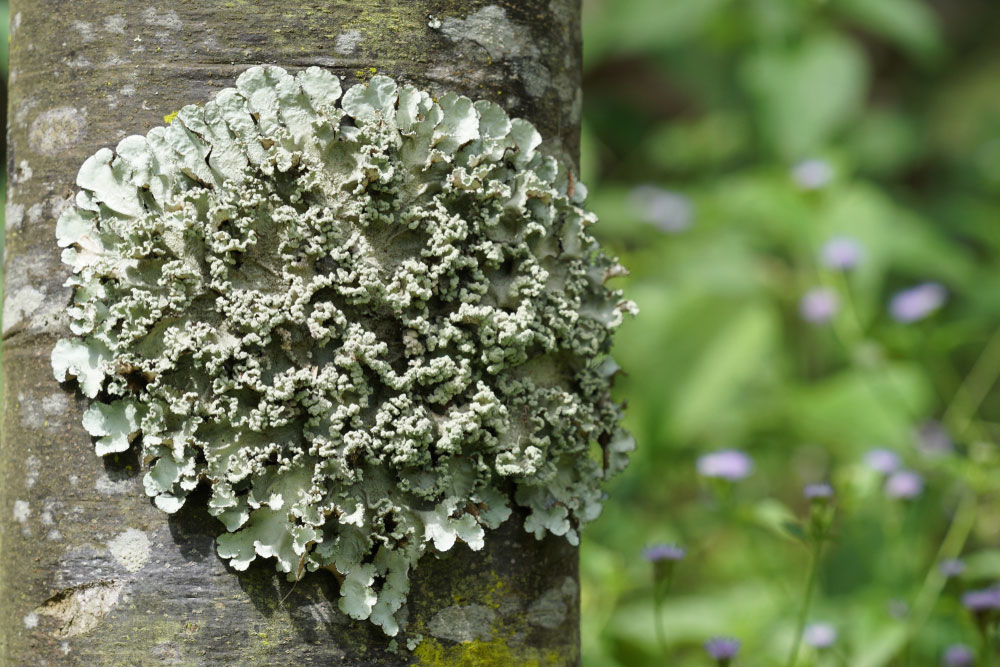
Animal Diversity I
Phylum Porifera
Consist of sponges
Believed to have evolved from flagellated aquatic eukaryotes known as choanoflagellates
Adults are sessile, they don’t move
Larvae do move though
Outer structure consists of fibrous collagen and calcareous or siliceous crystalline spicules and spongin, a collagenous protein in many species
Sponge anatomy:
Bodies are organized around a system of water canals and chambers
Ostia — openings that allow water into the sponges interior
Spongocoel — the central cavity of a sponge
Choanocytes — flagellated collar like cells that line the spongocoel
Gemmules — buds sponges form to reproduce asexually
Osculum — the opening in the sponge that water exits from
Mesohyl — a gelatinous matrix that the cells of sponges are arranged in
Amoebocytes — cells that move around the mesohyl and absorb, digest, and transport food
Sponge canal system:
Asconoid — sponges are small and tube shaped, water enters through tiny ostia and exits through a large osculum
Synconoid — have a more complex canal system, with choanocytes in numerous radial canals that empty into the spongocoel, then exits through the osculum
Leuconoid — sponges form large masses, with clusters of flagellated chambers received water from the canals, with discharged water leaving through the excurrent canals and osculum
Sponge Classification:
Class Calcarea: small marine sponges with spicules composed of calcium carbonate. May be vase-shaped, brightly colored, can have any body form
Class Demospongiae: largest class of sponges, often brilliantly colored. THey have siliceous spicules sometimes bound together by spongin and have leuconoid canal systems. Some members live in freshwater habitats.
Class Hexactinellida: known as glass sponges because of their six rayed siliceous spicules that form a glass-like lattice. These sponges are primary deep-water marine forms with cylindrical or funnel-shaped bodies. They can have simple syconoid or leuconoid flagellated chambers.
Phylum Cnidaria
Named after the cnidoblasts which contain stinging cells or nematocysts used for food gathering and defense
Two main body forms:
Medusa — like jellyfish
Polyp — like coral
Larvae called planula
Exhibit radial symmetry and are diploblastic
Reproduction can be asexual via budding, or sexual
Cnidaria Classification:
Class Hydrozoa — mostly marine, dominant polyp form
Class Scyphzoa — solitary medusas
Class Cubozoa — have a prominent Medusa form
Class Anthozoa — colonial or solitary polyps
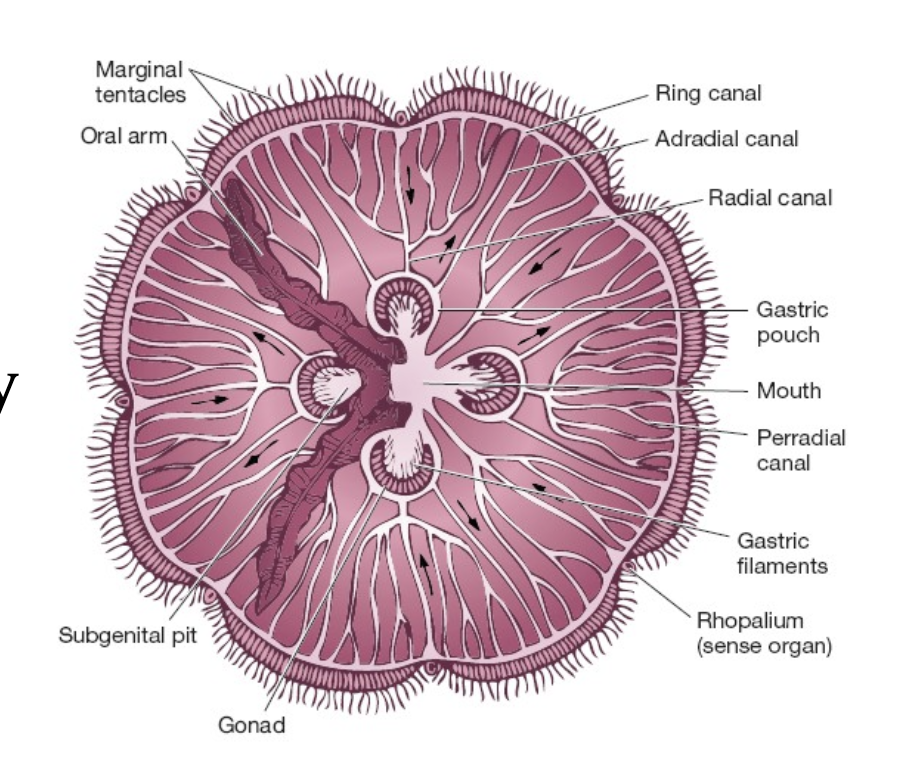
Phylum Ctenophora
Solitary, harmless, exclusively marine, jellyfish like animals
Also known as sea walnuts/sea gooseberries
Very small phylum
Exist as a medusa only
Live in warm water worldwide
Have adhesive cells called colloblasts to capture food
Do not possess nematocysts, meaning they can’t sting you
Swim by rows of fused cilia called comb plates
Most are monoecious, reproduce only sexually, many are bioluminescent
Phylum Platyhelminthes
Dorsoventrally flattened, ribbonlike bodies
Bilaterally symmetrical, triploblastic acoelomates with a large surface area
Many species are monoecious and practice cross-fertilization
Gas exchange occurs via diffusion
Their digestive system is incomplete, only one hole
They exhibit cephalization: a pair of cerebral ganglia receiving sensory information from the environment
Eye spots are present in some species. Each ganglion is connected to a nerve cord that runs the length of the body
Platyhelminthes Classification
Class Turbellaria: free-living flatworms
Class Cestoda: parasitic tapeworms
Trematoda: parasitic flukes. Largest class
Monogenea: ectoparasitic flatworms usually found on the skin and gills of fishes
Phylum Rotifera
Pseudocoelomates that live in aquatic environments
Possess a crown of cilia on their head, known as a corona, which is used for feeding and movement
Have a foot that contains adhesive glands that open to the exterior via spurs
Have a unique pharyngeal apparatus called the mastax, which possesses grinding jaws used for grinding up algae and smaller invertebrates
They have a complete digestive system
Rotifers lack a circulatory system and respire through their body surface
Rotifers are dioecious, with generally larger females than males
To cope with environmental stress, rotifers can enter an arrested state of activity called cryptobiosis, which can last up to 4 years
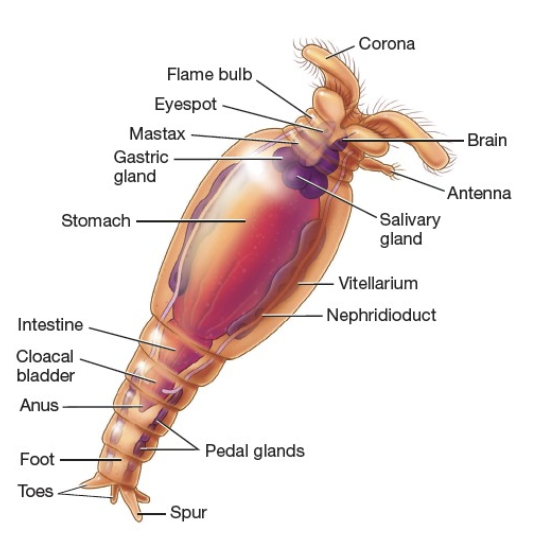
Phylum Mollusca
Super diverse but share a bilaterally symmetrical body plan
Foot - thick muscle used for digging, grasping, and movement
Visceral mass - contains the digestive, respiratory, circulatory, and reproductive systems
Mantle - a sheath of skin extending from the visceral mass and hanging down each side of the body, protecting the soft parts of the organism
Shell - composed of calcium carbonate and a protein matrix
Radula - protrusible, tonguelike organ used for rasping
Terrestrial snails have lungs for gas exchange
Classification of Mollusks
Polyplacophora — chitons
Monoplacophora — organisms with a cap-like shell
Gastropoda — snails, abalone, whelks, limpets, slugs and nudibranchs
Cephalopoda — octopi, squid, cuttlefish, nautiluses, and fossil ammonites
Bivalvia — calms, oysters, mussels, scallops
Scaphopoda — tusk shells
Bivalve Characteristics
Two separate shells joined by a ligament called the hinge
The umbo is the oldest part of the shell. It looks like a large hump on the top of the shell
Powerful adductor muscles hold the valves of the shell together. Most bivalves have a posterior and an anterior adductor muscle. Scallops just have one
They lack a head and radula
Bivalves live in marine as well as freshwater environments
Most are filter feeders
They take in water and nutrients in the incurrent siphon and eliminate by the excurrent siphon
Gas exchange occurs through the mantle and gills

Animal Diversity II
Phylum Chordata
Fundamental characteristics:
A notochord, dorsal nerve chord, pharyngeal pouches, and a postanal tail.These can exist throughout life or only during embryological development
Additional traits:
Bilateral symmetry
Segmentation
Radial cleavage
Triploblastic
Deuterostomes
Subphylum Vertebrata
All members have a skull
Have a neural crest, group of embryonic cells that form cranium, jaws, teeth, and some nerves
Metabolically more active, more complex muscular system
Have a multi-chambered heart and hemoglobin
Specialized organs, like liver and kidneys
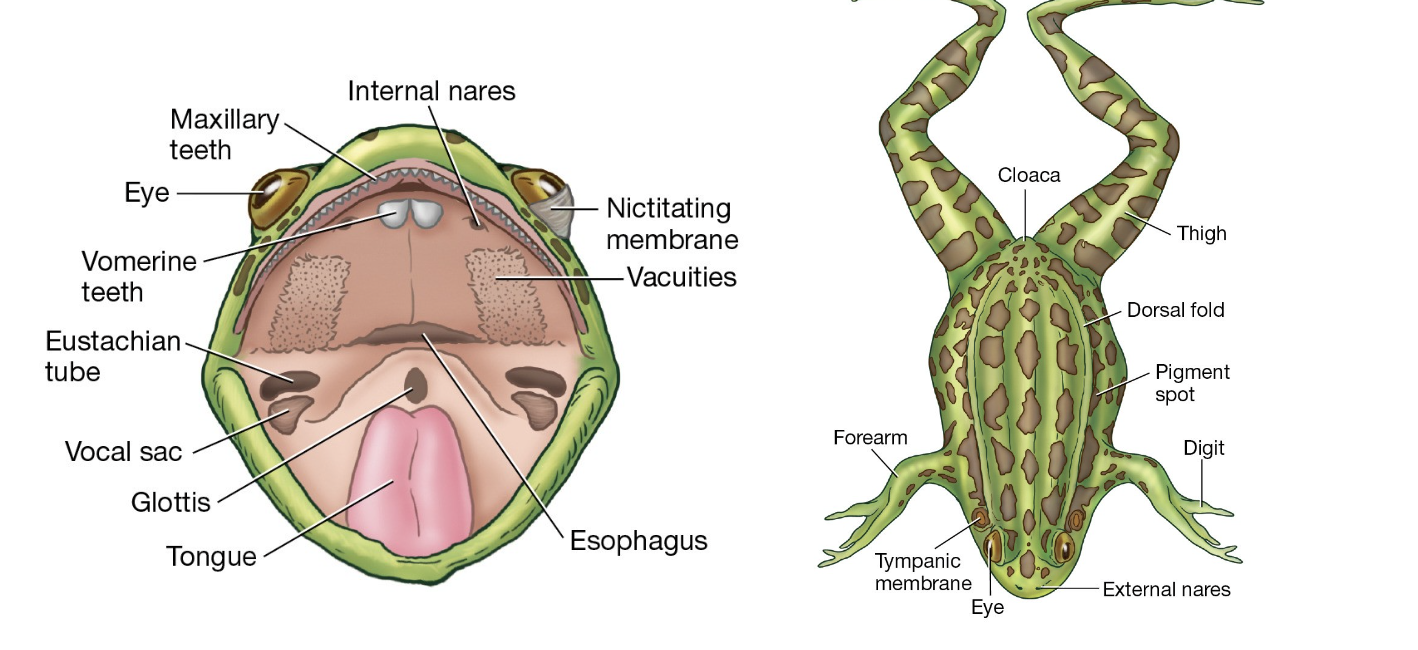
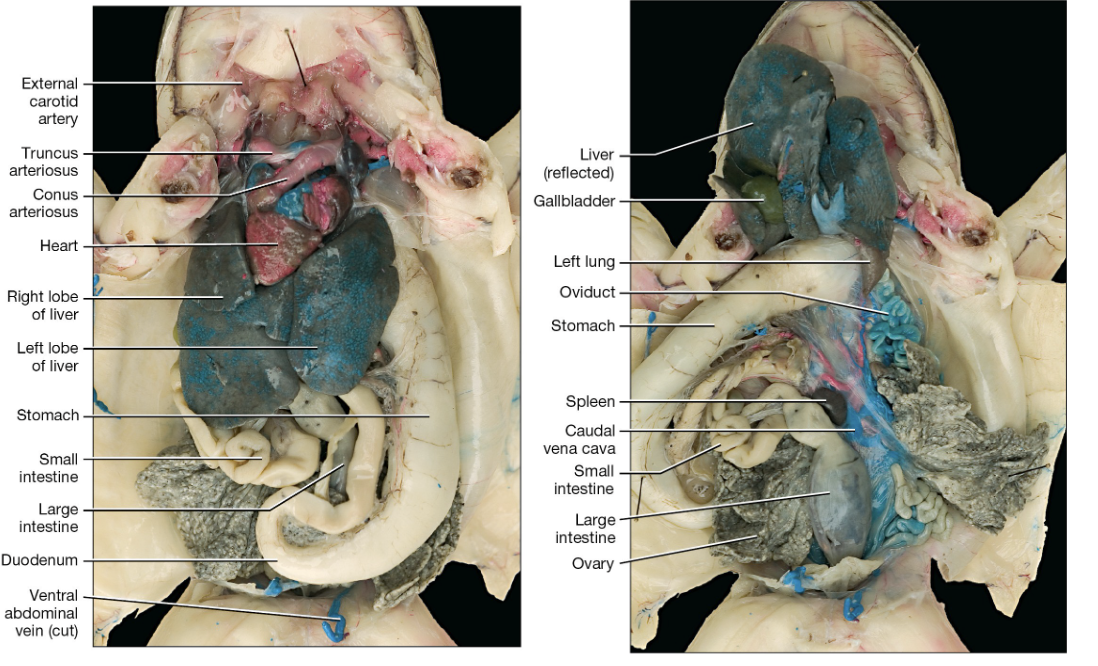
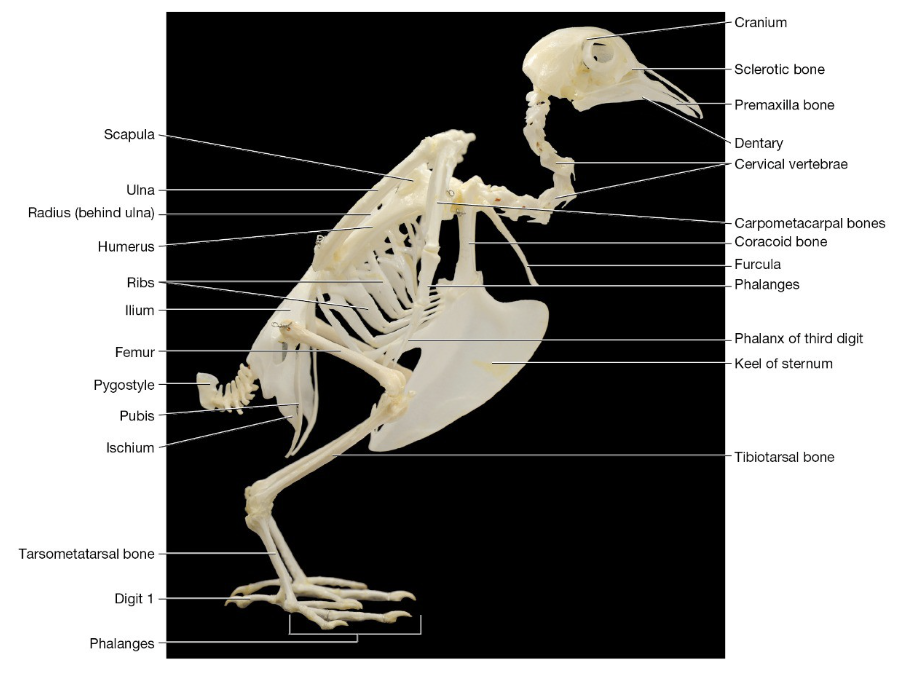
Phylum Echinodermata
Sea stars, feather stars, urchins, and sea cucumbers
Pentamerous (5-pointed) radial symmetry
Body wall consists of small calcareous ossicles that include surface spines
The spines can have pedicellariae that discharge organisms from gettin on them
Possess a unique water vascular system that allows them to be moving, feeding, sensing, and gas exchangin
Sea stars have tube feet
Lack head, brain, and segmentation
Dioecious, most have complete digestive system
Larva are bilaterally symmetrical, called bipinaria
Can lose a limb to avoid being caught by predators, known as autonomy
Subphylum Cephalochordata
Sea lancets
Inhabit sandy coastal waters, bury their posterior end into the sand and stick their anterior end above the sand to filter feed
Notochord and nerve chord persist
Complex, closed circulatory system of gas exchange
Have segmented repeating muscle units called myomeres
Water enters the mouth and passes to the endostyle, where it’s trapped by mucus and moved to the hepatic cecum where it’s digested

Phylum Arthropoda
A chitinous exoskeleton — some are soft and some are hard
Bilateral symmetry
Head, thorax, and abdomen
Possess a variety of sense organs, such as compound eyes and antennae
Coelomates
Complete digestive system with foregut, midgut, and hindgut
Have efficient tracheae (airtubes) that bring oxygen directly to the cells
Open circulatory system
Many undergo metamorphic changes
Females are usually oviparous (egg-laying)
Lab Practical 2
Fungal and Lichen Diversity
General characteristics of fungi:
Filamentous
Spore-producing
Heterotrophic
Unicellular or multicellular
Possess a chitin cell wall, store energy in the form of glycogen
Mostly decomposers, but some are parasitic or mutualistic
Release digestive enzymes onto a food source to dissolve it
Hyphae — numerous small filaments that compose multicellular fungi
Mycelium — grouped together mass of hyphae
Septa — cross walls of hyphae that allow structures like ribosomes and mitochondria to pass through
Rhizoids — modified hyphae that anchor fungi into substrate
Basidiomycota
Mushrooms, shelf fungi, and puffballs
Produce basidiospores (similar to the ascus)
Some can be edible

Chytridiomycota
Most ancient group of fungi
Most chytrids are either aquatic decomposers feeding on dead material or parasites living on water molds, insects, or snakes
Cell walls composed of chitin
Have flagellated spores and gametes
Most are unicellular
Can be found outside of water in moist environments

Ascomycoda
Largest and most diverse phylum of fungi
Lives pretty much anywhere
Can be unicellular or multicellular
Gets their name from the ascus, a large saclike cell responsible for producing reproductive ascospores
Fruiting bodies are called ascocarps

Zygomycota:
Bread molds
Reproduce via conjugation
The hyphae lack septa and are called coenocytic
Three types of hyphae: rhizoids anchor hyphae, stolons grow horizontally on the surface
Asexual life cycle: rhizoids make sporangiophores, which make two progametangia that meet and form a zygosporangium, which releases meiospores


Lichen
Symbionts consisting of a green algae or cyanobacterium
Algal cells or cyanobacteria are thought to provide food for both symbionts through photosynthesis and the ascomycete retains water and minerals, anchors the organism, and protects the algae
Nearly 20,000 species
Body is called a thallus and mainly reproduce asexually
Typically live on trees, rocks, and human structures. But can also live in crazy conditions
Associated with making dyes, litmus paper, bandages, and antibiotics. They help build soil, provide food and habitat, some fix nitrogen and are indicators of air pollution.
Three types:
Crustose: form brightly colored patches or crusts on rock or tree bark
Foliose: appear to have leaf like thalli that overlap, forming a scaly, lobed body. Found on tree bark and human made structures
Fruticose: appear shrub-like or hanging mosslike on trees. Thalli are highly branched or cylindrical.

Animal Diversity I
Phylum Porifera
Consist of sponges
Believed to have evolved from flagellated aquatic eukaryotes known as choanoflagellates
Adults are sessile, they don’t move
Larvae do move though
Outer structure consists of fibrous collagen and calcareous or siliceous crystalline spicules and spongin, a collagenous protein in many species
Sponge anatomy:
Bodies are organized around a system of water canals and chambers
Ostia — openings that allow water into the sponges interior
Spongocoel — the central cavity of a sponge
Choanocytes — flagellated collar like cells that line the spongocoel
Gemmules — buds sponges form to reproduce asexually
Osculum — the opening in the sponge that water exits from
Mesohyl — a gelatinous matrix that the cells of sponges are arranged in
Amoebocytes — cells that move around the mesohyl and absorb, digest, and transport food
Sponge canal system:
Asconoid — sponges are small and tube shaped, water enters through tiny ostia and exits through a large osculum
Synconoid — have a more complex canal system, with choanocytes in numerous radial canals that empty into the spongocoel, then exits through the osculum
Leuconoid — sponges form large masses, with clusters of flagellated chambers received water from the canals, with discharged water leaving through the excurrent canals and osculum
Sponge Classification:
Class Calcarea: small marine sponges with spicules composed of calcium carbonate. May be vase-shaped, brightly colored, can have any body form
Class Demospongiae: largest class of sponges, often brilliantly colored. THey have siliceous spicules sometimes bound together by spongin and have leuconoid canal systems. Some members live in freshwater habitats.
Class Hexactinellida: known as glass sponges because of their six rayed siliceous spicules that form a glass-like lattice. These sponges are primary deep-water marine forms with cylindrical or funnel-shaped bodies. They can have simple syconoid or leuconoid flagellated chambers.
Phylum Cnidaria
Named after the cnidoblasts which contain stinging cells or nematocysts used for food gathering and defense
Two main body forms:
Medusa — like jellyfish
Polyp — like coral
Larvae called planula
Exhibit radial symmetry and are diploblastic
Reproduction can be asexual via budding, or sexual
Cnidaria Classification:
Class Hydrozoa — mostly marine, dominant polyp form
Class Scyphzoa — solitary medusas
Class Cubozoa — have a prominent Medusa form
Class Anthozoa — colonial or solitary polyps

Phylum Ctenophora
Solitary, harmless, exclusively marine, jellyfish like animals
Also known as sea walnuts/sea gooseberries
Very small phylum
Exist as a medusa only
Live in warm water worldwide
Have adhesive cells called colloblasts to capture food
Do not possess nematocysts, meaning they can’t sting you
Swim by rows of fused cilia called comb plates
Most are monoecious, reproduce only sexually, many are bioluminescent
Phylum Platyhelminthes
Dorsoventrally flattened, ribbonlike bodies
Bilaterally symmetrical, triploblastic acoelomates with a large surface area
Many species are monoecious and practice cross-fertilization
Gas exchange occurs via diffusion
Their digestive system is incomplete, only one hole
They exhibit cephalization: a pair of cerebral ganglia receiving sensory information from the environment
Eye spots are present in some species. Each ganglion is connected to a nerve cord that runs the length of the body
Platyhelminthes Classification
Class Turbellaria: free-living flatworms
Class Cestoda: parasitic tapeworms
Trematoda: parasitic flukes. Largest class
Monogenea: ectoparasitic flatworms usually found on the skin and gills of fishes
Phylum Rotifera
Pseudocoelomates that live in aquatic environments
Possess a crown of cilia on their head, known as a corona, which is used for feeding and movement
Have a foot that contains adhesive glands that open to the exterior via spurs
Have a unique pharyngeal apparatus called the mastax, which possesses grinding jaws used for grinding up algae and smaller invertebrates
They have a complete digestive system
Rotifers lack a circulatory system and respire through their body surface
Rotifers are dioecious, with generally larger females than males
To cope with environmental stress, rotifers can enter an arrested state of activity called cryptobiosis, which can last up to 4 years

Phylum Mollusca
Super diverse but share a bilaterally symmetrical body plan
Foot - thick muscle used for digging, grasping, and movement
Visceral mass - contains the digestive, respiratory, circulatory, and reproductive systems
Mantle - a sheath of skin extending from the visceral mass and hanging down each side of the body, protecting the soft parts of the organism
Shell - composed of calcium carbonate and a protein matrix
Radula - protrusible, tonguelike organ used for rasping
Terrestrial snails have lungs for gas exchange
Classification of Mollusks
Polyplacophora — chitons
Monoplacophora — organisms with a cap-like shell
Gastropoda — snails, abalone, whelks, limpets, slugs and nudibranchs
Cephalopoda — octopi, squid, cuttlefish, nautiluses, and fossil ammonites
Bivalvia — calms, oysters, mussels, scallops
Scaphopoda — tusk shells
Bivalve Characteristics
Two separate shells joined by a ligament called the hinge
The umbo is the oldest part of the shell. It looks like a large hump on the top of the shell
Powerful adductor muscles hold the valves of the shell together. Most bivalves have a posterior and an anterior adductor muscle. Scallops just have one
They lack a head and radula
Bivalves live in marine as well as freshwater environments
Most are filter feeders
They take in water and nutrients in the incurrent siphon and eliminate by the excurrent siphon
Gas exchange occurs through the mantle and gills

Animal Diversity II
Phylum Chordata
Fundamental characteristics:
A notochord, dorsal nerve chord, pharyngeal pouches, and a postanal tail.These can exist throughout life or only during embryological development
Additional traits:
Bilateral symmetry
Segmentation
Radial cleavage
Triploblastic
Deuterostomes
Subphylum Vertebrata
All members have a skull
Have a neural crest, group of embryonic cells that form cranium, jaws, teeth, and some nerves
Metabolically more active, more complex muscular system
Have a multi-chambered heart and hemoglobin
Specialized organs, like liver and kidneys



Phylum Echinodermata
Sea stars, feather stars, urchins, and sea cucumbers
Pentamerous (5-pointed) radial symmetry
Body wall consists of small calcareous ossicles that include surface spines
The spines can have pedicellariae that discharge organisms from gettin on them
Possess a unique water vascular system that allows them to be moving, feeding, sensing, and gas exchangin
Sea stars have tube feet
Lack head, brain, and segmentation
Dioecious, most have complete digestive system
Larva are bilaterally symmetrical, called bipinaria
Can lose a limb to avoid being caught by predators, known as autonomy
Subphylum Cephalochordata
Sea lancets
Inhabit sandy coastal waters, bury their posterior end into the sand and stick their anterior end above the sand to filter feed
Notochord and nerve chord persist
Complex, closed circulatory system of gas exchange
Have segmented repeating muscle units called myomeres
Water enters the mouth and passes to the endostyle, where it’s trapped by mucus and moved to the hepatic cecum where it’s digested

Phylum Arthropoda
A chitinous exoskeleton — some are soft and some are hard
Bilateral symmetry
Head, thorax, and abdomen
Possess a variety of sense organs, such as compound eyes and antennae
Coelomates
Complete digestive system with foregut, midgut, and hindgut
Have efficient tracheae (airtubes) that bring oxygen directly to the cells
Open circulatory system
Many undergo metamorphic changes
Females are usually oviparous (egg-laying)
 Knowt
Knowt